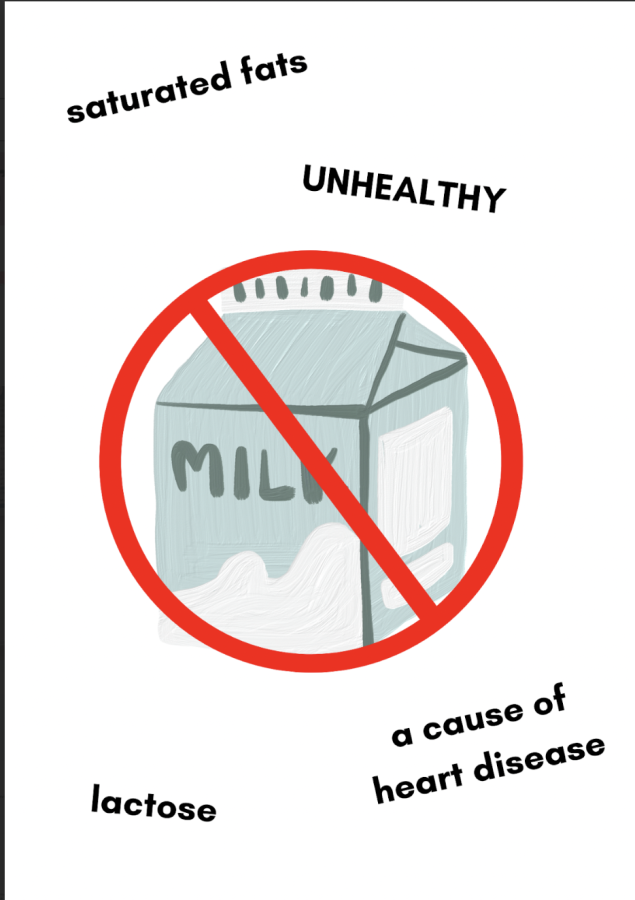Choosing milk that’s best for consumers is udder chaos
With more research continuously coming out about the negative consequences of dairy consumption, traditional cow’s milk is increasingly being eschewed in favor of plant-based alternatives.
May 30, 2023
Do you know what is udder-ly bad for you? Regular cow’s milk. Moreover, milk and other dairy products have long been flagged for their high levels of saturated fat and their outsized role as a causative factor of the heart diseases, type 2 diabetes and Alzheimer’s disease so common in America. When taken in conjunction with the fact that according to the National Institute of Health, about 68% of the world’s population is lactose intolerant, it can be seen that alternatives to regular dairy milk must be explored. However, among the many alternatives in the market, there are those that can passably replace milk and others that are extremely off-the-mark.
Best #1: Soy Milk
There is a reason why soy milk has dominated the public’s perception of alternatives to milk for decades: it is the most similar to cow’s milk, but without the worst parts of the latter. Moreover, soy milk is nutritionally very similar to cow’s milk, and is even included under the “dairy” category by the United States Department of Agriculture. Containing more protein per serving than the other popular choices of rice, almond or oat milk, its nutritional value cannot be denied. The distinct taste of soy milk can lead to strong opinions of the drink, but the general consensus leads towards the conclusion that its mild and creamy flavor tastes more like traditional milk than many other alternatives.
Best #2: Rice Milk
A big advantage of rice milk is that it is one of the most hypoallergenic of the alternatives, as it accounts for both lactose intolerance and nut allergies. Additionally, it contains very limited amounts of unsaturated fats and cholesterol, which are two of the main setbacks of traditional dairy milk. Although it has a rather watery texture, its mild and naturally sweet taste makes it a good fit for even the most picky eaters.
Best #3: Coconut Milk
Despite being one of the newer alternatives on the market, coconut milk is being heralded as possibly one of the best options because of its exceptional nutritional value. It is rich in a type of fat called medium-chain triglycerides, which can stimulate weight loss by making you feel full for longer and increasing insulin sensitivity. In terms of comparison to cow’s milk, its thick and creamy texture has been likened to the original, thus making it a valid substitute.
Worst #1: Hemp Milk
The one critical area that drops hemp milk down the rankings is its texture; its combination of a grainy, gritty consistency with a slimy aftertaste makes it unpleasant to drink; the best part of a glass of a milk is arguably the smoothness with which it goes down your throat, so because hemp milk abominably fails this aspect, it deserves last place. Additionally, proponents of hemp milk praise its “nutty” and “grassy” texture, but the question to ask here is: would you want to wash down your cookies with grassy-tasting milk?
Worst #2: Oat Milk
Although it is promoted as one of the best-tasting alternatives to regular milk, the reason behind that achievement is what gives it its place towards the bottom of the ranking: oat milk has 19.01 grams of sugar for every 240 milliliters, in comparison to the 0 grams of sugar in almond milk and hemp milk. Furthermore, oat milks are generally highly processed, containing thickeners, stabilizers and sometimes even oil, that only further hurt its nutritional value and organic integrity.
Worst #3: Almond Milk
Almond milk has a strong hold on the plant-based dairy market, with Food Dive reporting that it had 63% of the market in 2020. However, as more and more consumers strive to be environmentally conscious with their purchases, the outsized damage almond milk does to the environment is stepping into the spotlight. Various reports estimate that just one cup of almond milk requires more than two gallons of water, when water is becoming an increasingly valuable commodity, while also releasing more than three pounds of carbon dioxide into the atmosphere. Thus, because almond milk is hurting the planet at such a critical juncture in time for climate change prevention, consumers cannot in good conscience continue to support it.
Although the debate over which plant-based milk alternative is the best, in terms of taste, nutritional value and other factors, is on-going, it is a proven fact that these plant-based options are healthier than their traditional dairy counterparts. As such, as members of the WCHS community make nutritional choices regarding their diet, it is important to thoroughly analyze what kind of milk would be best for them.



